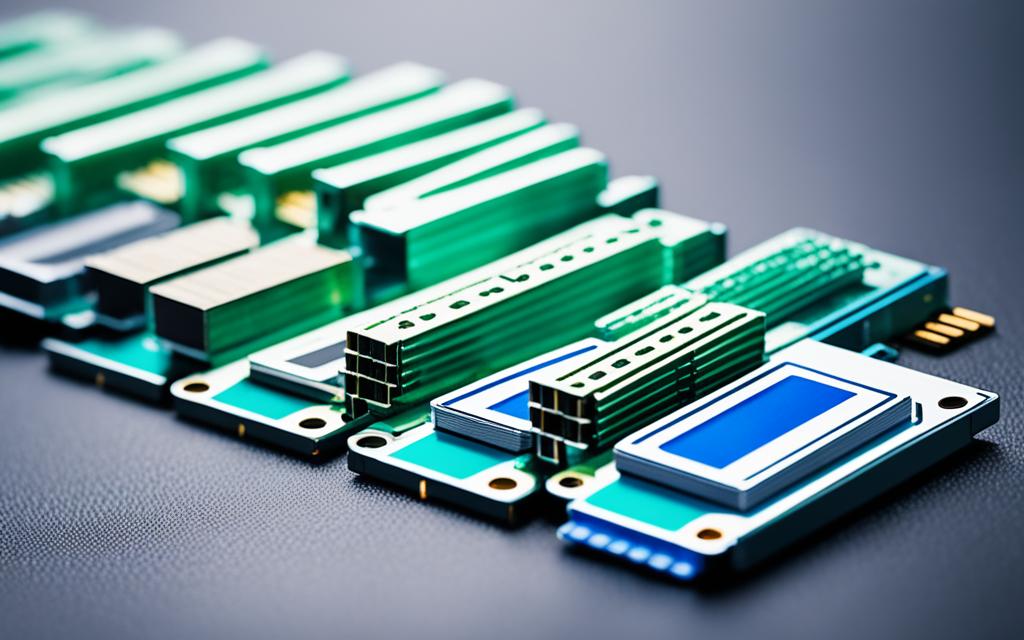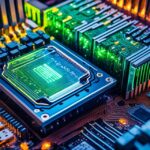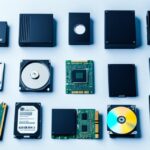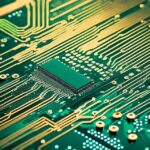Table of Contents
It’s crucial to know the difference between computer storage and computer memory to make your device work better. Computer memory, or RAM, keeps data short-term for apps to run smooth. On the other hand, computer storage holds your data even when the computer is off. Understanding these differences helps you make better upgrade choices. This boosts your device’s efficiency. Whether a casual or a power user, knowing this can improve your computer use1.
Key Takeaways
- Computer memory (RAM) is volatile, meaning data is lost when powered off.
- Computer storage provides permanent data retention, even without power.
- Causal users typically require at least 4GB of RAM and 256GB of storage2.
- Power users may need 16GB of RAM and up to 2TB of storage2.
- Upgrading RAM and storage can significantly boost system performance1.
- Memory and storage work hand-in-hand with the processor to enhance computing tasks1.
Understanding Computer Memory
Computer memory is key to a system’s speed and efficiency. It saves data for the processor to quickly access. There are two main kinds: volatile and non-volatile memory. Volatile memory, like RAM, loses its data when the power goes off. It is crucial for storing temporary data. Non-volatile memory keeps information even when there is no power. This is important for keeping data long-term.
Definition and Functionality
RAM, or Random Access Memory, is a volatile type for temporary data. It works at high speeds. This lets the system get and change data much quicker than using hard drives. There is also cache memory. It is a small, fast memory on the CPU chip. It stores often-used data for fast access. This makes processing efficient, allowing for easy multitasking and better system response.
Types of Memory
We use various memory types for different computing tasks. The most common include:
- Static RAM (SRAM): Uses flip-flops for storing data and needs constant power.
- Dynamic RAM (DRAM): Uses electrical capacitors and must be refreshed often, about 50 times a second.
- Read-Only Memory (ROM): A non-volatile type storing data permanently, important for starting up and other critical functions.
- Synchronous DRAM (SDRAM): Matches the system bus speed to improve access times.
Choosing the right memory greatly affects how a system works. More RAM means more data can be processed at once. This boosts speed3. Knowing about these memory types helps users boost their computing, especially for high-speed tasks and storage needs.
Understanding Computer Storage
Computer storage is where your data lives permanently. It’s a place for documents, apps, and photos. This part talks about what storage means, how it works, and the different kinds available. Hard drives, solid state drives (SSDs), and cloud storage are the main focus.
Definition and Functionality
Storage keeps data for the long run, different from memory’s short-term use. Devices like hard drives and SSDs store crucial stuff. This includes your operating system, apps, and personal files. The speed of storage affects how fast your computer starts and runs4. Upgrading it can really boost your computer’s power, especially for big tasks5.
Types of Storage Devices
Knowing the types of storage helps you choose what’s best for you. There are a few main kinds:
- Hard Drives (HDDs): They use spinning disks to work. HDDs have lots of space for a cheaper price, but they’re not as quick as newer tech.
- Solid State Drives (SSDs): SSDs have no moving parts and use flash memory. This makes them quick to start and load things. They’re also small and run cool, which is handy for many5.
- Cloud Storage: With the internet, this storage lets you access your data from any device. It’s scalable and secure, making it a good choice if you need flexibility6.
What is the Difference Between Computer Storage and Computer Memory
Understanding computer memory and storage is key to better computing. Computer memory, like RAM, is for temporary data. It holds active files and programs for quick processing. On the other hand, storage keeps data safe even when the computer is off. This includes things like documents and apps.
Temporary vs Permanent Data Storage
RAM is for temporary data, helping computers work fast. Its data is lost when the computer turns off. This makes it great for tasks that need speed. For example, running software moves data from storage, like SSDs, to RAM for quick use7.
Permanent storage, on the other hand, keeps files safe long-term. This includes SSDs, hard drives, and USB drives. They store your important files for as long as needed7.
Usage Scenarios for Memory and Storage
In gaming or professional settings, RAM’s fast access is crucial. Its speed helps more than disk or flash storage8. But for large data storage, like extensive databases, different strategies are needed. Small businesses may need 1-2TB, while data-heavy ones could require more than 10TB9. Knowing the difference between memory and storage enhances performance, highlighting their unique roles.
The Importance of Memory in Your Computer
Memory plays a vital role in computers. It greatly affects how well your system performs. The RAM, or Random Access Memory, holds data your computer needs quickly. This makes your computer run more efficiently. So, picking the right amount of memory is key for the best performance.
How Memory Affects Performance
Enough memory is crucial for a smooth-running computer. Most come with 4GB to 32GB of RAM. This lets them handle various tasks easily10. More RAM generally means your computer can do more at once. It’s especially true for demanding programs.
For simple things like browsing the web or using social media, 4 to 8GB of RAM is enough10. But if you’re into gaming or work with big files, you might need 16GB or more10. This helps your computer to work better for you.
Recommended Memory Sizes for Different Users
Choosing the right memory size depends on how you use your computer. Here’s a guide to help you decide:
| User Type | Recommended Memory Size | Typical Tasks |
|---|---|---|
| Casual Users | 4GB – 8GB | Web browsing, streaming, social media |
| Professional Users | 8GB – 16GB | Office applications, data analysis, moderate gaming |
| Power Users | 16GB or more | Gaming, video editing, working with large files |
The Role of Storage in Your Computer
Storage plays a crucial role in a computer’s efficiency and performance. It allows you to store multimedia files, applications, and documents smoothly. It’s key to choose the right storage solutions to boost your computer’s functionality.
How Storage Capacity Impacts Functionality
Storage size affects how fast and efficient a computer runs. Computers with larger hard drives can manage more data easily. This helps avoid slowdowns with big files or many applications. Hard drives differ in size, offering gigabytes to terabytes of space11. Though hard drives have lots of space, Solid State Drives (SSDs) work faster but have less space12.
Choosing the Right Storage Solution
Choosing storage needs thinking about use, size needed, and budget. It’s important to balance speed with storage amount. HDDs have more space but are slower than SSDs, which are faster but pricier. You also need to pick the right size, like 2.5-inch or 3.5-inch. Knowing about HDDs, SSDs, SD cards, and DVDs is vital12.
| Storage Type | Speed (Measured in MB/s) | Typical Capacity | Cost per GB |
|---|---|---|---|
| HDD | 80-160 | 500 GB to 10 TB | £0.03 – £0.05 |
| SSD | 200-550 | 128 GB to 4 TB | £0.12 – £0.30 |
| SD Cards | 10-70 | 2 GB to 1 TB | £0.05 – £0.50 |
A smart strategy in choosing storage can make a big difference to your computer. By thinking carefully about these factors, you can find the best storage for your needs. This will help your computer work better11.
When to Upgrade Memory or Storage
Knowing when to upgrade memory or upgrade storage is key for a smooth-running computer. Spotting the right time for an upgrade can greatly enhance performance.
Signs Your Memory Needs an Upgrade
If your applications open slowly, or your computer lags or crashes with many tabs open, it’s a sign. Modern computers usually have at least 8GB of memory. However, for simple tasks, 4GB might be enough, but 8GB is advisable for professional work132.
- Applications taking longer to load
- System freezes during multitasking
- Inability to run more demanding software
Signs Your Storage Needs an Upgrade
Spotting storage upgrade signs is also crucial. Watch out for nearly full storage, long app load times, or slow booting. Upgrading to an SSD can cut boot times to around 10-13 seconds from 30-4013. If saving files or running apps is slow, consider upgrading your storage.
- Warnings about low disk space
- Prolonged loading times for programs
- Files taking too long to save or retrieve
| Upgrade Type | Freeing Up Space | Performance Impact |
|---|---|---|
| Memory Upgrade | Close unnecessary programs | Reduces lag; smoother multitasking |
| Storage Upgrade | Delete old files; offload to external drives | Faster application load times |
How Memory and Storage Work Together
Understanding how memory and storage work together is key for a computer to run well. They help the processor handle data more quickly and effectively. This makes the computer’s operations fast and efficient.
Interaction Between Memory, Storage, and Processor
Data moves from storage to memory to be easily accessed by the processor. This is crucial for a system’s efficiency. If the processor needs certain info, it gets it from storage. This process must be smooth for quick operations.
RAM is a key type of memory because it stores data for a short time for fast use. As the processor does its job, the Northbridge chip manages the data flow between the GPU, RAM, and CPU14. The Southbridge chip deals with slower devices like hard drives and peripherals14.
How fast the CPU can work with information in the memory affects the computer’s speed14. A well-optimized memory and storage system makes multitasking easier and performs better.
The kind of storage, like SSDs or HDDs, affects this process too. SSDs, for example, can make data access much faster. This, in turn, speeds up how the computer processes data15. So, the storage’s speed and the memory’s size are both very important.
| Component | Function | Impact on Performance |
|---|---|---|
| RAM | Holds data and instructions for fast access | Increases speed of data processing |
| Northbridge Chip | Controls data transfer among CPU, RAM, and GPU | Enhances communication speed |
| Storage Devices (SSD/HDD) | Stores data long-term | Affects data retrieval speed |
| CPU | Processes instructions at defined frequencies | Determines overall system speed |
Understanding how these parts work together can help people choose the right upgrades. This ensures memory and storage help the processor handle data better16.
Conclusion
It’s important to know the key differences between computer storage and memory. This knowledge is crucial for anyone wanting to improve their computer’s performance. Computer memory, like RAM and cache, lets you quickly access data for current tasks. On the other hand, computer storage, such as HDDs and SSDs, keeps your information safe over time, even when your computer is off. This helps users understand what they need for speed and keeping data safe.
Data is growing fast, expected to hit 163 zettabytes by 20251718,). Knowing how memory and storage work together is key. RAM gets you the data you need quickly, making your computer efficient. Storage solutions manage your data long-term. This knowledge leads to making smart upgrades for better performance.
For the best computing experience, balancing memory and storage is crucial. Using the right tech and upgrading when necessary helps your computer stay quick and ready for the growing amount of data. It’s about knowing and doing—the right mix for improved productivity and efficiency. kmh>
FAQ
What is the main difference between computer storage and computer memory?
Computer storage keeps files, applications, and documents for a long time. In contrast, computer memory, or RAM, helps access data quickly for ongoing tasks.
Why is RAM considered volatile memory?
RAM is called volatile because it loses its data once the power is off. Non-volatile memory, on the other hand, keeps data without power.
What types of memory are available for computers?
Computers have volatile memory, like DRAM, for temporary data. They also have non-volatile memory, like ROM, which keeps data even when turned off.
How do hard drives differ from solid state drives (SSDs)?
Hard drives use spinning disks and offer more space at a lower cost. SSDs, however, are quicker and more reliable but cost more per gigabyte.
What indicates that I need to upgrade my computer memory?
You might need more memory if apps open slowly, multitasking lags, or if heavy programs run sluggishly.
What factors should I consider when choosing storage for my computer?
Think about what files you store, how much space you need (for activities like gaming, media editing), and choose between internal or external storage. Also, compare SSDs and hard drives for cost and performance.
How do memory and storage work together in a() computer?
Memory and storage work together by transferring data from storage to be processed in memory. This is key to a quick and smooth user experience, especially during complex tasks.
How do I know if my storage is reaching capacity?
You’ll know if storage is full when you get warnings, files open slowly, and saving new data reduces system performance.
Source Links
- https://www.crucial.com/articles/about-memory/what-is-the-difference-between-memory-and-storage – The Difference Between Memory and Storage
- https://www.hp.com/gb-en/shop/tech-takes/computer-memory-vs-storage – Difference Between Computer Memory vs. Storage | HP® Tech Takes
- http://backupeverything.co.uk/difference-between-memory-and-storage/ – Difference Between Memory and Storage – Backup Everything
- https://www.kingston.com/en/blog/pc-performance/difference-between-memory-storage – What is the difference between memory and storage?- Kingston Technology
- https://www.backblaze.com/blog/whats-diff-ram-vs-storage/ – Memory vs. Storage: A Look at What They Are and What They Do
- https://www.geeksforgeeks.org/difference-between-memory-and-storage/ – Difference between Memory and Storage – GeeksforGeeks
- https://www.pcmag.com/encyclopedia/term/storage-vs-memory – Definition of storage vs. memory
- https://www.techtarget.com/searchstorage/answer/What-is-the-difference-between-memory-and-storage – What is the difference between memory and storage? | TechTarget
- https://www.servermania.com/kb/articles/memory-vs-storage – Memory vs Storage – What is the difference?
- https://www.linkedin.com/pulse/difference-between-memory-storage-paul-zdzitowiecki – The Difference Between Memory and Storage
- https://www.geeksforgeeks.org/difference-between-memory-and-hard-disk/ – Difference between Memory and Hard Disk – GeeksforGeeks
- https://www.javatpoint.com/memory-vs-storage – Difference Between Memory and Storage – javatpoint
- https://www.kingston.com/en/blog/pc-performance/memory-vs-storage-pc-performance – Memory vs Storage: PC Performance
- https://www.partitionwizard.com/clone-disk/how-do-computers-work.html – How Do Computers Work: Motherboard, CPU, RAM, and Hard Drive – MiniTool Partition Wizard
- https://www.siyavula.com/read/za/computer-applications-technology/grade-11/storage-memory-and-processing-devices/03-storage-memory-and-processing-devices – 3.1 Storage devices | Storage, memory and processing devices
- https://www.geeksforgeeks.org/introduction-to-memory-and-memory-units/ – Introduction to memory and memory units – GeeksforGeeks
- https://www.purestorage.com/au/knowledge/what-is-computer-memory.html – What Is Computer Memory | Pure Storage
- https://www.techtarget.com/searchstorage/definition/storage – What is computer storage and how is it used?








